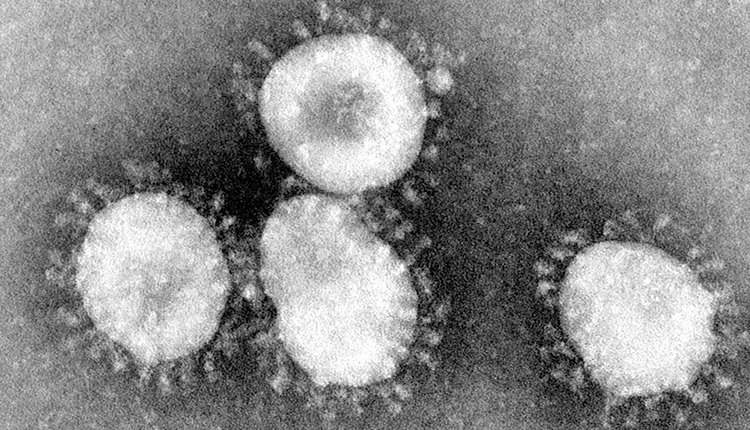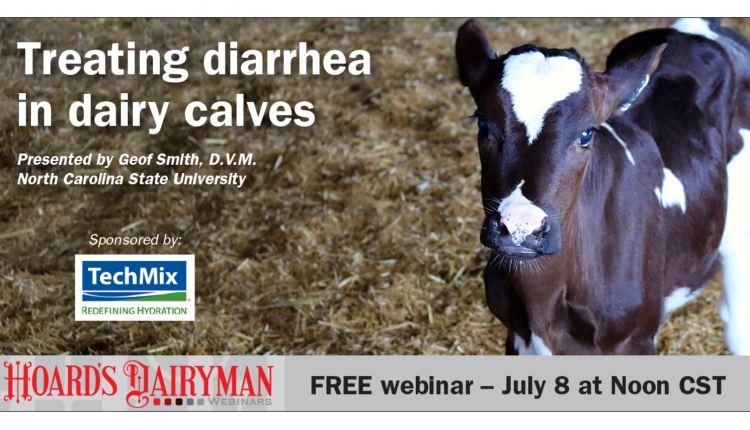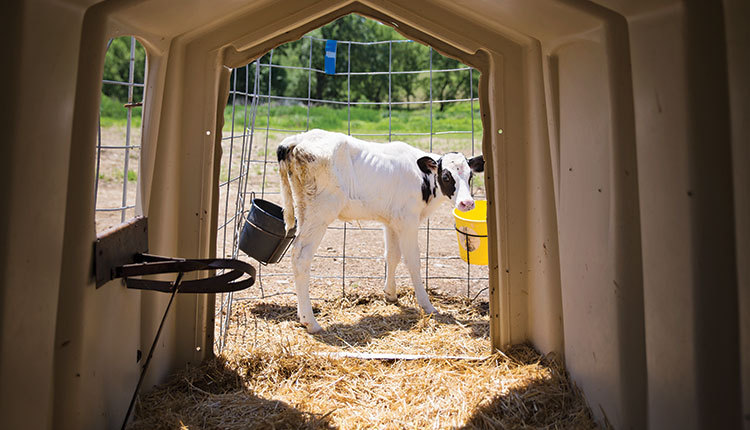The author is at the College of Veterinary Medicine, North Carolina State University, Raleigh.
Diarrhea continues to be the biggest health problem we face in raising calves. It is important to be able to recognize these calves quickly and begin appropriate treatment to maintain hydration and to prevent or correct the blood acidosis that occurs in many calves.
When a calf is first noted with diarrhea, it is important to determine how "sick" the calf is. This, in turn, will dictate how aggressive your treatment needs to be. Generally, I separate calves with diarrhea into two categories - those that can still stand and will suck and calves that can't stand up on their own. Generally, calves that still can stand and suck can be treated with oral fluids with good success. In contrast, calves that already are down generally have a severe acidosis of their blood and need intravenous fluids.
Also, I try to determine how dehydrated the calves are during my initial examination. This is fairly easy once you know what to look for. Assessing hydration status is done most accurately by looking at the calf's eyeballs.
Normally, the eye should be right up against the bottom eyelid. With the calf's head restrained, take your thumb and roll down the bottom eyelid. There shouldn't be any gap or "space" between the eyelid and the eyeball.
Dehydrated calves develop eyeball recession . . . their eyes begin to "sink" back into their head some. When you roll the bottom eyelid down with your thumb, you will notice a gap between the eyelid and the eyeball. The more sunken the eyes, generally the more severe the dehydration (see photos below).

Check the eyes. The calf above (left) has a normal hydration status. There is no space between the eyelid and the eyeball. However, the calf at right is severely dehydrated. The eye is sunken at least 7 to 8 mm into the orbit.
Another way to assess dehydration is to pinch the skin over the neck, twist it about 90 degrees, and let it go. In a normal calf, the skin should snap right back in place. In dehydrated calves, the skin returns much more slowly. The table has some general guideline for assessing dehydration in calves.
Fluid therapy . . .
Oral electrolytes are recommended for any calf with diarrhea that still is standing and has at least a weak suckle reflex. They will replace fluids and electrolytes (such as sodium and chloride) that are lost in the diarrhea. They also will correct the acidosis that commonly is present in the blood of these calves, and they also may provide some nutritional support.
In general, a calf with any sort of suckle reflex or one that demonstrates any "chewing" action can be considered to tolerate oral fluids safely. You can give oral electrolytes one to two times per day as needed to maintain hydration in calves with diarrhea.
If the calf will not stand up or is more than moderately dehydrated, usually intravenous fluids are necessary. You should contact your veterinarian. Oral fluids alone often are not sufficient when a calf becomes very dehydrated or has a severe acidosis of the blood.
Whether or not to use antibiotics in calves with diarrhea is somewhat controversial, even among veterinarians. Almost everyone would agree that antibiotics are indicated in calves that have diarrhea plus some other sign of a systemic bacterial infection. (This would include calves with rectal temperature greater than 103°F, bloody diarrhea, swollen joints or umbilicus, and so forth.)

However, what about the calf that has simple diarrhea with no evidence of any other significant problem? Many experts would say that antibiotics are not necessary in these cases. Simply keep the calf hydrated with fluids until the diarrhea resolves and everything should be fine.
Other veterinarians (including myself) feel that antibiotic use may be indicated even in these simple, uncomplicated cases. We have known for years that calves with diarrhea have greater numbers of gram-negative bacteria in their small intestine. This buildup occurs no matter what is actually causing the diarrhea itself, and it generally persists well after the main disease is gone.
We also know that a significant number of calves with simple diarrhea develop bacteremia. This means they actually have bacteria circulating in their bloodstream. Several studies have shown that bacteria can be cultured from the blood of calves with simple diarrhea in about 30 to 40 percent of cases.
When we review all of the major studies done on calves with diarrhea during the past 30 to 40 years, the results consistently show that those treated with antibiotics have lower mortality rates, higher growth rates. So, while not everyone will agree antibiotics are necessary in every case of diarrhea, they certainly may be worth including in your diarrhea treatment protocols.
One other treatment that has shown to be useful in calves with fevers (above 103°F) or bloody diarrhea is flunixin meglumine. This is an anti-inflammatory drug that can speed recovery in very sick calves with diarrhea. Studies have shown that giving one or two doses of flunixin (24 hours apart) can result in fewer "sick" days when compared to calves that did not receive this drug. I don't believe it's indicated in all cases of diarrhea but certainly in calves with elevated rectal temperature or if there's a significant amount of blood present in the diarrhea.
There have been other treatments recommended by veterinarians in the past. However, in my opinion, the cornerstone of therapy should be fluids, antibiotics, and perhaps an anti-inflammatory drug. The use of products that "protect" the intestine (like Pepto-Bismol) is not recommended; nor do I recommend drugs that alter the motility of the gut. There are some drugs that slow down the intestines (and thus give the impression that the diarrhea is resolving). However, these products do not speed the rate of overall recovery. Although some research has been done on the use of probiotic products, I am not aware of research suggesting any benefit.
The flow chart shows a sample treatment protocol for calves with diarrhea. This is only a guideline and may not be applicable to all farms. I would encourage you to work with your veterinarian and set up a similar protocol tailored specifically to your herd. With early identification of diarrhea and aggressive treatment, most calves will recover quickly.

Diarrhea continues to be the biggest health problem we face in raising calves. It is important to be able to recognize these calves quickly and begin appropriate treatment to maintain hydration and to prevent or correct the blood acidosis that occurs in many calves.
When a calf is first noted with diarrhea, it is important to determine how "sick" the calf is. This, in turn, will dictate how aggressive your treatment needs to be. Generally, I separate calves with diarrhea into two categories - those that can still stand and will suck and calves that can't stand up on their own. Generally, calves that still can stand and suck can be treated with oral fluids with good success. In contrast, calves that already are down generally have a severe acidosis of their blood and need intravenous fluids.
Also, I try to determine how dehydrated the calves are during my initial examination. This is fairly easy once you know what to look for. Assessing hydration status is done most accurately by looking at the calf's eyeballs.
Normally, the eye should be right up against the bottom eyelid. With the calf's head restrained, take your thumb and roll down the bottom eyelid. There shouldn't be any gap or "space" between the eyelid and the eyeball.
Dehydrated calves develop eyeball recession . . . their eyes begin to "sink" back into their head some. When you roll the bottom eyelid down with your thumb, you will notice a gap between the eyelid and the eyeball. The more sunken the eyes, generally the more severe the dehydration (see photos below).

Another way to assess dehydration is to pinch the skin over the neck, twist it about 90 degrees, and let it go. In a normal calf, the skin should snap right back in place. In dehydrated calves, the skin returns much more slowly. The table has some general guideline for assessing dehydration in calves.
Fluid therapy . . .
Oral electrolytes are recommended for any calf with diarrhea that still is standing and has at least a weak suckle reflex. They will replace fluids and electrolytes (such as sodium and chloride) that are lost in the diarrhea. They also will correct the acidosis that commonly is present in the blood of these calves, and they also may provide some nutritional support.
In general, a calf with any sort of suckle reflex or one that demonstrates any "chewing" action can be considered to tolerate oral fluids safely. You can give oral electrolytes one to two times per day as needed to maintain hydration in calves with diarrhea.
If the calf will not stand up or is more than moderately dehydrated, usually intravenous fluids are necessary. You should contact your veterinarian. Oral fluids alone often are not sufficient when a calf becomes very dehydrated or has a severe acidosis of the blood.
Whether or not to use antibiotics in calves with diarrhea is somewhat controversial, even among veterinarians. Almost everyone would agree that antibiotics are indicated in calves that have diarrhea plus some other sign of a systemic bacterial infection. (This would include calves with rectal temperature greater than 103°F, bloody diarrhea, swollen joints or umbilicus, and so forth.)

However, what about the calf that has simple diarrhea with no evidence of any other significant problem? Many experts would say that antibiotics are not necessary in these cases. Simply keep the calf hydrated with fluids until the diarrhea resolves and everything should be fine.
Other veterinarians (including myself) feel that antibiotic use may be indicated even in these simple, uncomplicated cases. We have known for years that calves with diarrhea have greater numbers of gram-negative bacteria in their small intestine. This buildup occurs no matter what is actually causing the diarrhea itself, and it generally persists well after the main disease is gone.
We also know that a significant number of calves with simple diarrhea develop bacteremia. This means they actually have bacteria circulating in their bloodstream. Several studies have shown that bacteria can be cultured from the blood of calves with simple diarrhea in about 30 to 40 percent of cases.
When we review all of the major studies done on calves with diarrhea during the past 30 to 40 years, the results consistently show that those treated with antibiotics have lower mortality rates, higher growth rates. So, while not everyone will agree antibiotics are necessary in every case of diarrhea, they certainly may be worth including in your diarrhea treatment protocols.
One other treatment that has shown to be useful in calves with fevers (above 103°F) or bloody diarrhea is flunixin meglumine. This is an anti-inflammatory drug that can speed recovery in very sick calves with diarrhea. Studies have shown that giving one or two doses of flunixin (24 hours apart) can result in fewer "sick" days when compared to calves that did not receive this drug. I don't believe it's indicated in all cases of diarrhea but certainly in calves with elevated rectal temperature or if there's a significant amount of blood present in the diarrhea.
There have been other treatments recommended by veterinarians in the past. However, in my opinion, the cornerstone of therapy should be fluids, antibiotics, and perhaps an anti-inflammatory drug. The use of products that "protect" the intestine (like Pepto-Bismol) is not recommended; nor do I recommend drugs that alter the motility of the gut. There are some drugs that slow down the intestines (and thus give the impression that the diarrhea is resolving). However, these products do not speed the rate of overall recovery. Although some research has been done on the use of probiotic products, I am not aware of research suggesting any benefit.
The flow chart shows a sample treatment protocol for calves with diarrhea. This is only a guideline and may not be applicable to all farms. I would encourage you to work with your veterinarian and set up a similar protocol tailored specifically to your herd. With early identification of diarrhea and aggressive treatment, most calves will recover quickly.












